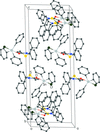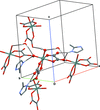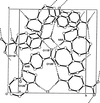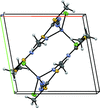issue contents
March 2016 issue

Cover illustration: In recent years, `Li-stuffed' garnets have gained considerable interest as promising electrolyte materials for all-solid-state Li-ion batteries because of an increased Li-ion mobility. Gallium-substituted lithium lanthanum zirconate (Ga-LLZO), Li6.43Ga0.52La2.67Zr2O12, is such an `Li-stuffed' garnet, with gallium atoms found both on two lithium sites and on the lanthanum position. In contrast to the space group type Ia![]() d typically observed for these structures, in the structure of Ga-LLZO a reduction of the symmetry to space group type I
d typically observed for these structures, in the structure of Ga-LLZO a reduction of the symmetry to space group type I![]() 3d is observed. See: Robben, Merzlyakova, Heitjans & Gesing [Acta Cryst. (2016). E72, 287-289].
3d is observed. See: Robben, Merzlyakova, Heitjans & Gesing [Acta Cryst. (2016). E72, 287-289].
research communications
















































































 journal menu
journal menu

























































